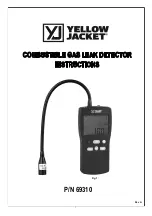
Operating Instructions
205
Using Performance Validation
This section describes the benefits of the Performance Validation System and explains how to set up
the metal detector for PV testing, with information about each of the parameters that need to be
specified.
Regular checking of the metal detector’s sensitivity should be a normal part of any quality assurance
procedure. This is particularly important should it become necessary to demonstrate due diligence to
address customer or legislative requirements.
One approach is to make regular sensitivity checks and keep handwritten records of the results.
To assist in maintaining quality assurance controls the metal detector includes an automatic
Performance Validation System. This can be set up to automatically prompt the operator to perform
quality assurance checks on a regular basis. It then guides the operator through a test sequence
using standard test samples. At the end of the Performance Validation test the results are saved in
memory and can be outputted in a number of ways.
See the
Logs and Reports
section for further details.
Performance Validation System
PV tests can be used to ensure regular in line testing of metal sensitivities occur. Records of PVS
activity can either be captured using the report option together with for example a LomaEnet system,
or by use of the PVS Log whose data can be downloaded to a USB stick in the form of a “.csv” file
that can be opened using Windows Excel. Either option can replace the need for manual records.
The requirement for a PV test can be prompted for by the detector on a regular basis or manually
initiated. When detector prompted the user has a timed window in which to successfully complete the
requirements of the test. This time window is user definable. Optional visible or audible remote/ local
warning of the test prompting may or can be fitted.
To set up PV testing, the PVS option must first be enabled in the User Options screen so that the
PVS Setup screen can be selected from the System Settings screen. The PVS Setup screen is used
to set when PV test are to be carried out and what type of testing is to be done. These settings are
then applicable for all products that have the PVS option enabled.
For each product the PVS option can be enabled through the Product Settings screen and the test
sample types and sizes to be used selected.
A complete set up comprises test type, timing, number of test piece passes required, allotted test
completion time, test piece size and type (Ferrous, Non-ferrous and Stainless Steel) based upon the
specification for the specific product/detector relationship and a false threshold value. All the settings
are explained within the screen help associated with their location.
If the user has password protected the detector keyboard; a separate password can be assigned for
the test that allows access to only the functions needed to complete the test. This ensures the
detector set up integrity is preserved.
To run a test is simply a matter of pressing a single key in answer to the screen message. The system
automatically prompts for an operator ID (traceability) followed by the previously programmed
size/type/quantity of metal contaminants. Each successful pass is indicated upon the control unit
display, with a final +Suc message upon completion of the full test sequence. When running a
test sequence the correct operation of the reject device together with any confirm systems in use
must form part of the test. The test sequence can be aborted at any time or run at anytime.
Failure to respond to a test prompt or successfully complete a test within the allotted time window, will
result in a fault condition being generated. Operation of the reject on a permanent basis will occur,
together with conveyor stoppage should the conveyor control circuits be connected through the
detector fault relay circuit. The option to generate this condition from a test failure is user selectable.
During the running of a test the signal levels generated can be viewed to enable fault diagnosis in the
event of the correct test pieces not being detected.
Normal operation of the detector is not impaired at anytime during testing; therefore the user is not at
risk of allowing genuinely contaminated product past the detector. This also allows the reject system
to be checked for correct operation.
Содержание IQ3+
Страница 2: ......
Страница 36: ...Safety First 26 THIS PAGE IS INTENTIONALLY LEFT BLANK ...
Страница 43: ...Installation 33 ...
Страница 60: ...Installation 50 THIS PAGE IS INTENTIONALLY LEFT BLANK ...
Страница 70: ...About the Metal Detector Range 60 THIS PAGE IS INTENTIONALLY LEFT BLANK ...
Страница 218: ...Operating Instructions 208 THIS IS PAGE INTENTIONALLY LEFT BLANK ...
Страница 244: ...Maintenance 234 THIS PAGE IS INTENTIONALLY LEFT BLANK ...
Страница 248: ...Glossary 238 THIS PAGE IS INTENTIONALLY LEFT BLANK ...
















































